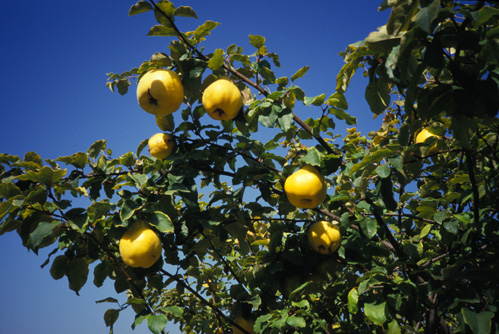The quince (Cydonia oblonga), a native of the Middle East, has a long history of cultivation throughout the Mediterranean region. It was first cultivated in Mesopotamia (modern
Iraq) and is believed to have travelled to Greece between 200 and 100 BC. Revered in ancient Greece as a symbol of
fertility, the quince is mentioned in Greek writings about 600 BC as a ritual item in wedding ceremonies. Homer’s Odyssey mentions it as an important garden plant, and the ancient
Roman naturalist Pliny the Elder has extolled its medicinal qualities. Today the world’s leading quince cultivator is Turkey, which makes up about 25% of its total production, followed by
Iran, China, Argentina and Morocco. In India, the fruit is grown in Kashmir, Himachal Pradesh, Punjab and the Nilgiris.
The tree is a small deciduous one with gnarled and crooked branches, growing to a height of 15 to 20 feet. The leaves are oval or oblong, dark green above and grey underneath, turning a rich yellow in autumn. Flowers are fivepetalled, white or pale pink in colour, and attractive in
appearance. The fruit is pear-shaped with a tough, waxy skin that is golden yellow in colour. The pulp is white and firm, with a gritty taste and a rich aroma.
A rich source of dietary fibre, the quince is low in calories and high in vitamin C. It is a good source of minerals such as copper, iron and potassium as well as the B-complex vitamins.
Most quince varieties are too hard and sour to eat raw. However, the fruit has numerous culinary uses. It can be baked whole, stewed, made into pies and tarts, and cooked with
apples. Because of its high pectin content, it lends itself readily to jellies, jams and preserves. Dulce de membrillo, or quince paste, a sweet, fragrant, jellylike confection cut into slices or
served with cheese, is a popular delicacy in many European countries. In Armenia, the quince is used in several sweet and savoury dishes, and is cooked with lamb. Quince brandy is a popular drink in the Balkan regions.
The quince has many other, non-food uses as well. Because
of its strong pleasing fragrance, the fruit was used in ancient times as a room freshener. Today it is used as a base for a pomander (a mixture of fragrant flower petals and herbs) hung
as a decoration or given as a Christmas gift. The tree and its parts have many medicinal uses. The stem bark is used in
Chinese medicine in the treatment of ulcers. The seeds, soaked in water, form a mucilaginous mass that is used to treat respiratory diseases and applied as a salve to treat burns. In many Middle Eastern countries, the dried fruit is used to treat sore throat and to relieve cough. The juice of the fruit is also used as a mouthwash to treat mouth ulcers and gum problems.
Subscribe to Child Project Helper by Email




